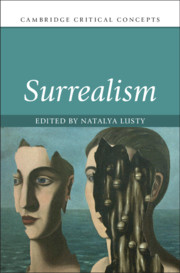Book contents
- Surrealism
- Cambridge Critical Concepts
- Surrealism
- Copyright page
- Contents
- Illustrations
- Notes on Contributors
- Acknowledgments
- Introduction: Surrealism’s Critical Legacy
- Part I Origins: Ideas/Concepts/Interventions
- Chapter 1 The Surrealist World
- Chapter 2 Psychoanalysis
- Chapter 3 Surrealism and the Demand of Politics
- Chapter 4 Modern Science
- Chapter 5 Surrealism and Dreams
- Chapter 6 Surrealism and Eros
- Part II Developments: Practices/Cultures/Material Forms
- Part III Applications: Heterodoxies and New Worlds
- Select Bibliography
- Index
Chapter 2 - Psychoanalysis
from Part I - Origins: Ideas/Concepts/Interventions
Published online by Cambridge University Press: 23 July 2021
- Surrealism
- Cambridge Critical Concepts
- Surrealism
- Copyright page
- Contents
- Illustrations
- Notes on Contributors
- Acknowledgments
- Introduction: Surrealism’s Critical Legacy
- Part I Origins: Ideas/Concepts/Interventions
- Chapter 1 The Surrealist World
- Chapter 2 Psychoanalysis
- Chapter 3 Surrealism and the Demand of Politics
- Chapter 4 Modern Science
- Chapter 5 Surrealism and Dreams
- Chapter 6 Surrealism and Eros
- Part II Developments: Practices/Cultures/Material Forms
- Part III Applications: Heterodoxies and New Worlds
- Select Bibliography
- Index
Summary
This chapter examines Freudian psychoanalysis as a source of inspiration and ambivalence for Surrealism. Freudian postulates such as the centrality of subconscious activity in human behavior and its manifestation through automatic processes helped determine surrealist methods of art-making and poetical practice in the movement’s early years. Yet surrealists would gradually reappraise their reliance on automatism and other key psychoanalytical concepts which had been appropriated into the movement’s theoretical body, mainly by André Breton. Breton and his coterie developed forms of creative activity based on a looser interpretation of the inner life; in doing so, they helped provide inspiration for new psychoanalytic concepts – the most notable example was Jacques Lacan and Salvador Dalí’s iterative notion of paranoia. This novel understanding of the disorder illustrated how the same idée fixe could appear to manifest itself in different external phenomena by virtue of the subject’s delirious projections. The chapter demonstrates that, while Surrealism was influenced by psychoanalysis at its inception, in its later years it was Surrealism that influenced psychoanalysis.
- Type
- Chapter
- Information
- Surrealism , pp. 46 - 62Publisher: Cambridge University PressPrint publication year: 2021
- 1
- Cited by

